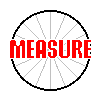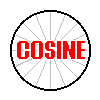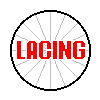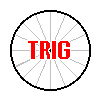



















| |
| |




















|




















| |
| |




















|
Maybe one day I will have enough time to work on a wheel building page and pass on what I have learned, but for now I have this to offer. The site linked to below from Harris Cyclery gives about the best wheel building instructions I have found on the Internet. I will give some of my thoughts about wheel building right below. If you are building your first wheel(s), you should start with a conventional pattern, radial, 2 cross, 3 cross, or 4 cross, depending on the wheel you are building (do not lace a rear all radial). You might want to print this page and the Harris Cyclery site out, to have them handy, you should definitely copy the to your desktop. It will talk at least one hour to build your first front wheel, and probably about two for your first rear.
You should not build a front wheel with different lacing patterns on the different sides. This will just make the wheel off-balance and it could loose true easier. Different lacing patterns on the different sides of a front won't do anything to the wheel to make it better. Even with front disc wheels for a mountain bike, the offset is not enough that different lacing's will help out the finished wheel. With a rear wheel however, different lacing patterns on each side can make for a stronger wheel (I give more information about this on the LACING page), but I don't suggest trying a mixed lacing on your first wheel, it's a little tricky and having wheel building experience can really help.
When you lace a wheel it will be easier if you start with spokes for both sides that feed into the flanges from the outside of the flange (the spoke heads end up visible on the outside of the flanges), and finish with the sets that feed into the flanges from the inside (the spoke heads end up on the inside of the flanges). This will allow the last spokes you thread into the wheel to be free, not trapped between the spokes on the opposite flange, and they will only have to cross the spoke(s) it is crossing on it's flange. If you are doing a complex lacing, like a rear wheel where the sides are laced differently, it is the easiest to lace one side at a time and start the last side threading the spokes as just explained.
Unlike what Sheldon Brown describes for tensioning the wheel, I have found that squeezing the spokes in pairs by hand works well to relieve the initial spoke twist and have the spokes seat without a lot of windup. The way he suggests, using a spare crank to relieve sets of spokes, might damage the spokes if the crank is forced to hard. Besides, how many people have spare cranks that they wouldn't mind marring? Also if you tried to use a wrench or large screw driver instead of a crank, the pressure that could be applied might bend or over-stress the spokes.
I use the two following methods to relieve the spokes in wheel when I build:Squeeze the spokes in pairs using the valve hole has a reference, it is easiest to do this with the wheel still in the truing stand. Squeeze each spoke twice, once with each neighboring spoke. Go around the wheel for two or three passes, starting and ending at the same spoke so they all get squeezed exactly twice per pass. The valve hole is a good reference point. Do this often during the building process, the tighter the wheel becomes the more you will need to do this to relieve the spokes. Once the wheel is tensioned and you are working on the final truing, relieve the spokes after each truing pass.An easy way to see if the spokes are getting wound-up when you are tightening the nipples is to grip the spoke with your free hand when you are tightening it. This usually only happens when the spokes are getting really tight and the wheel is just about done. By gripping the spoke you can feel the spoke twisting and tell when the nipple turns. When spokes are starting to twist, they can make a 'popping' noise when the nipple finally moves. If you feel the spoke twisting before the nipple tightens, go that much of a turn too far, and then back off that much to relieve the twist on the spoke.
After the wheel is tensioned, I work out the last spoke stress by doing the following. I lay the wheel flat with the hub axle on a block of wood, after removing the quick release, if it has one. I then press down on opposite sides of the rim, grabbing the rim on opposite sides, and turn the wheel a little after each press. You should press down in about eight places on each wheel half, which means press down four times total and spin the wheel about 1/8 of a turn between presses. You should press down hard enough to where you see some rim deflection, about 1/2 inch total, and you might hear some of the spokes 'ping' or 'pop'. You only need to go half way around, so use the valve hole for a reference point. Be careful with rear wheels. Front wheels can be very sturdy on both sides, but rears are weaker on the drive side. If you press too hard, you could over stress the spokes and bend the rim, so it's better to press a little too easy than too hard. I suggest you do the drive side of a rear first. This way you won't accidentally press down as hard as the non drive side and bend the rim. If you press too hard you will need to re-true the wheel and start over. It's also a good idea to fine tune true again, relieve the wheel as just described again.
I have found that tight wheels stay true better. Several pre-built wheel's that I've owned have had problems staying true. When I would tighten the nipples one or two full turns and then re-true the wheel, they stayed true a lot better. I have also done this for friends and solved their problems. I tend to tighten my front wheels and the drive side of the rear wheel until it feels like the nipple wrench is getting ready to round the nipple, or I do start rounding some nipples. The non drive side gets tightened enough to get the dish proper. After getting a few hundred miles on a new set of wheels I check the true. Front wheels usually are fine, but rears do tend to need to break in. After re-truing the rears after this break in, they stay true for a long time. I usually check and fine-tune the truing of my wheels a least once a year. This takes care of anything that happens from basic use.
If you have an old pair of wheels, especially a rear, that seems to go out of true on every ride, the problem is most likely the spokes have aged to the point that they are losing their strength and they stretch randomly when you go ride the bike. Each spoke sees hundreds of stress cycles for each mile the bike is ridden, and sprinting, hill climbing, and hard braking also subject the spokes to many stress cycles. All metals age from stress. When a wheel ages to this point, it's time to rebuild the wheel. You can re-use the hub and rim (if it's not too worn from braking) and just replace the spokes.

|
Harris Cyclery's Wheel Building |

|






